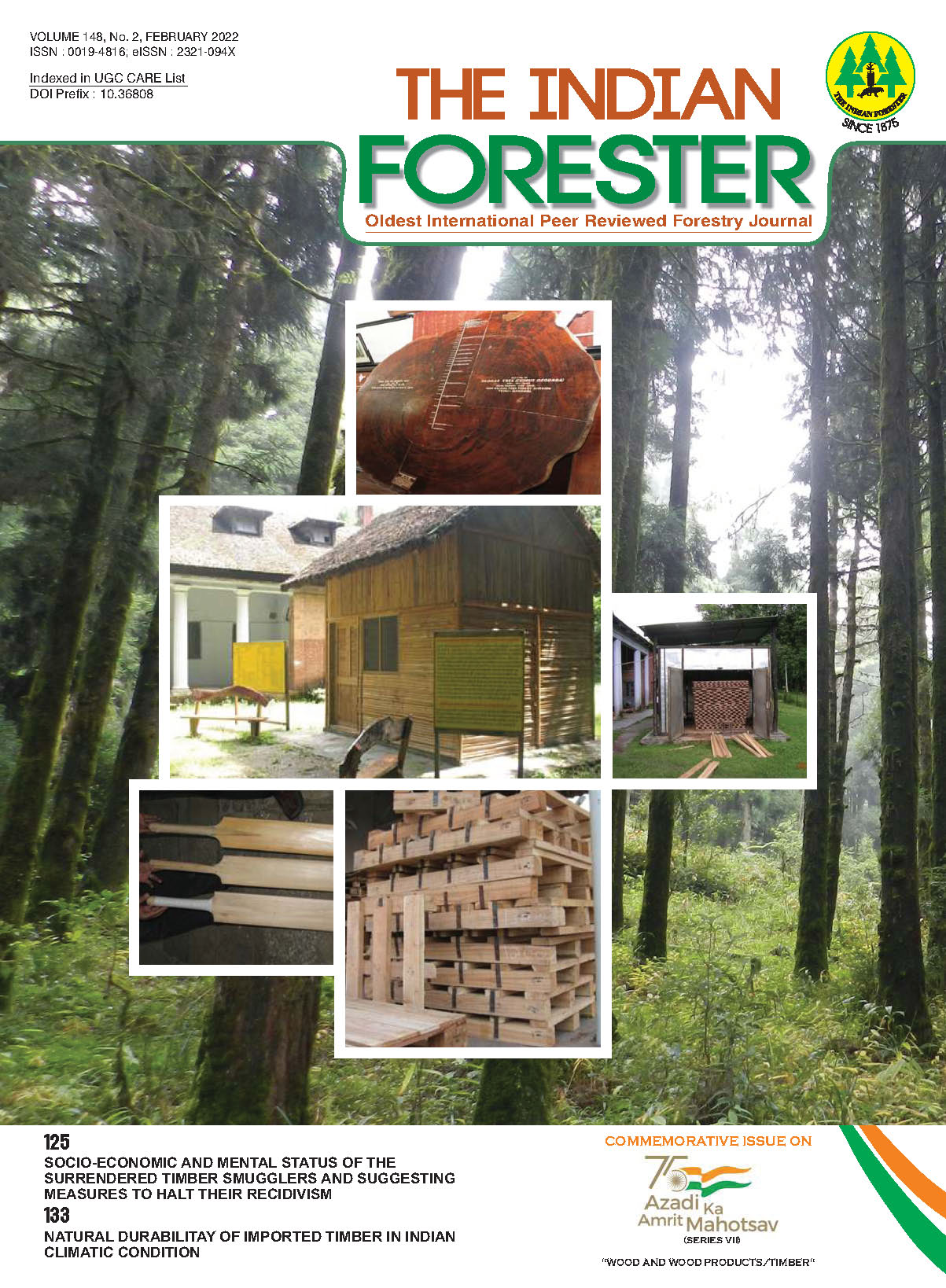Influence of Age on Kraft Pulping of Akashmoni (Acacia auriculiformis) Wood Species of Chattogram Hill Tract
DOI:
https://doi.org/10.36808/if/2022/v148i2/157341Keywords:
Akashmoni (Acacia auriculiformis), Debark, Age Groups, Strength Properties, Solubility.Abstract
This work evaluated the effect of cooking time, temperature and active alkali on different age group of akashmoni wood species. Pulps have been prepared from akashmoni at ages of 4, 6, 8, 10 and 12 years with kaft process. Cooks were made with active alkali and maintaining sulfidity 25% at 170°C. Pulp yield varied from 61.05 to 43.73% of various ages for akasmoni. Kappa number was found is bleachable grade for 6 and 8 years old akasmoni wood and others ages did not give bleachable grade pulp. The physical strength properties of akasmoni like tear, tensile and burst strength were determined. Paper properties of akashmoni kraft pulp compared favorably with those of other hardwood pulp are widely used in the world. Fair grade pulp is produced from eight year akashmoni wood.References
Akhtaruzzaman A.F.M. and Chowdhury A. R. (1991). Alkaline pulping of Paracerianthes falcataria with anthraquinone as an additive. Bangladesh Journal of Forest Science, 20(1&2): 37-43.
Akhtaruzzaman A.F.M., Das P. and Bose S.K. (1987). Effect of anthraquinone in alkaline pulping of Acacia auriculiformis. Bano Biggyan Patrica, 16(1&2): 3-9
Akhtaruzzaman A.F.M., Das P., Bose S.K. and Chowdhury A.R. (1997). Characterization of lesser- used/unused wood species for paper-pulp. Bulletin 1. Forest Products Branch, Bangladesh Forest Research Institute, Chittagong. pp 46-60.
Anon. (2017). Forest product statistics, FAO, Rome.
Anon. (1992). TAPPI standard. TAPPI, Atlanta-Georgia, TAPPI press.
Anon. (1980). Pulping and paper-making properties of fastgrowing plantation wood species, Food and agriculture organization of united stated Rome FAO page 53-62
Bose S.K., Chowdhury S.K., Chowdhury A.R. and Akhtaruzzaman A.F.M. (1995). Kraft pulping of twelve lesser used/unused low density hardwoods and softwood from Bangladesh. Bangladesh Journal of Forest Science, 24(2): 35-40.
Biswas D., Misbahuddin M., Roy U., Frncis R.C. and Bose S.K. (2011). Effect of additives on fiber yield improvement for kraft pulping of kadam (Anthocephalus chinensis). Bioresource Technology, 102(2): 1284-1288.
Biswas D., Misbahuddin M. and Roy U. (2012). Respons of Rajkorai (Albizia richardiana King and Prain)wood for various alkaline pulping process, Bangladesh Journal of Forest Science, 32(1): 45-52.
Biswas D., Misbahuddin M., Roy U. and Khatun N. (2017). Kraft pulping of Albizia richardiana wood species in a mixture with Bambusa vulgaris. Journal of Bamboo and Rattan. 16(2): 139-146.
Das D.K. and Alam M.K. (2001). Trees of Bangladesh. Bangladesh Forest Research Institute, Chittagong pp 10.
Das S. (1986). Nursery and plantation techniques for Acacia auriculiformis. Bulletin 7, Silviculture Research Division, Bangaldesh Forest Research Institute, Chittagong.
Davidson J. (1985). Species and sites. Field document. No.5, UNDP/FAO Project. BGD 179, Assistance to the Forestry Sector of Bangladesh pp 50.
Gellerstedt, Majtnerova A. and Zhang L. (2004). Toward a new concept of lignin condensation in kraft pulping: Initial results, Compets REndus Biologie's, 327: 817-826.
Haque M.M., Uddin M.N., Quaiyyum M.A. (2019). Pulp wood quality of the second generation Acacia auriculiformis. Journal of Bioresources and Bioproducts, 4(2): 73-79. DOI: 10.21967/jbb.v4i2.227
Hoque S.M.S., Osman X.T. and Mia F. (1991). Growth of Acacia auriculiformis, Dipteriacapus turbinatus and Pinus caribae at Chittagong University Studies, Part II, Science, 15(1):107-111.
Hossain S.M., Siddique A.B. and Das P. (1978). Kraft pulping studies of gamar (Gmelina arborea, Roxb) of different age group, Bano Biggyan Patrica, 7(1 &2); 14-19.
Hygreen J.G. and Bowyer J.N. (1982). Forest product and wood science an introduction, Iowa State University Press/First Edition/Third edition pp 495. Islam S.K., Islam M.S., Hossain M.A.T. and Alam Z. (2013).
Optimal rotation interval of Akashmoni (Acacia auriculiformis) plantation in Bangladesh, Kasetsart J. (Soc. Sci), 34: 181-190.
Jahan M.S., Chowdhury D.A.N. and Ni Y. (2010). Effect of different locations on the mlorphological, chemical, pulping and paper making properties of Trema orientalis (Nalita). Bioresource Technology, 101: 1882-1898.
Jahan M.S., Haider M.M., Rahman M., Biswas D., Misbahuddin M. and Mondol G.G. (2011). Evaluation of rubber wood (Hevia brasilliensis) as raw material for kraft pulping, Nordic Pulp and Paper Research Journal, 26(31): 258-262.
Kasmani J.E., Nemati M., Samariha A., Chitsazi H., Mohammadi S.N. and Nosrati H. (2011). Studying the effect of the age in Eucalyptus camaldulensis species on wood chemical compound used in pulping process, American- Eurasian J., Agric & Environ Sci., 11(6):854-856.
Khristova P., Kordsachia O. and Daffala S. (2004). Alkaline pulping of Acacia seyal, Tropical Science, 44(4): 207-215.DOI: 10.1002/ts.170.
Latif M.A., Rahman M.F. and Das S. (1995). Volume table of Acacia auriculiformis, Cassia siamea and Pinus caribae in Bangladesh, Bangladesh Journal of Forest Science, 4(2): 22-23.
Misbahuddin M., Biswas D. and Roy U. (2019). Suitability of eight years kadam tree (Neolamarckia cadamba) in chemical pulping. Nordic Pulp & Paper Research Journal, 34(4) 417–421, eISSN 2000-0669, ISSN 0283-2631, DOI: https://doi.org/10.1515/npprj-2019-0041.
Muneri A. (1997). Kraft pulping properties of Acacia mearnsil and Eucalyptus grandis growth in Zimbabwe, The southern African Forestry Journal, 179(I): 13-19. DOI: 10.1080/10295925.1997.9631148
Nyoman J.wistra, Carolina Anne and Namhunkim (2015). Effect of tree age and active alkhali on kraft pulping of white Jabon, Journal of the Korean Wood Science and Technology, 43(5):566-577. DOI :10.5658/WOOD.2015.43.5.566.
Rosli W.D.W.; Mazlam I. and Law K.N. (2009). Effect of residual effective alkali on eucalyptus kraft pulp yield and chemistry, Cellulose Chemistry and Technology, 43(1):9-15. DOI: 10.10071300226-008-0200-J.
Rydholm S.A. (1965). Pulping Process. First Edition, Interscience Publisher, New York- London- Sydney, PP: 99 and 1231.
Siddique A.B. and Chowdhury A.R. (1988). Fibre Studies of Pinus caribaea, Leucana leucocephala and Acacia auriculiformis, 17(1 & 2): 68-72.
Downloads
Downloads
Published
How to Cite
Issue
Section
License
Unless otherwise stated, copyright or similar rights in all materials presented on the site, including graphical images, are owned by Indian Forester.





